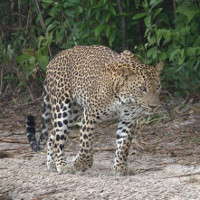 |
Sri Lankan panther |
|
He is a wild animal |
Origin |
Sri Lanka | |
Translation |
Francis Vandersteen |
| The possession of this animal is not authorized Royal Decree establishing the list of mammals not kept for production purposes that may be kept (M.B. 24.08.2009) |
| The Sri Lankan panther's coat color is generally golden fawn or reddish-brown, covered with open, cabbage-like black spots whose size varies with the animal's age: the spots are generally larger and farther apart in older animals. Its body is built for agility, hence its ability to climb trees: it has a powerful thorax and well-developed legs. The panther is renowned for its ability to blend into its environment. A solitary creature, it continually marks its territory to keep other animals at a distance. It is an excellent climber, capable of hoisting prey weighing up to twice its own weight. For the first few days after birth, the female stays close to her young. But she is soon forced to leave to hunt, leaving her young hidden in dense vegetation, rock crevices or hollow trees. The young are extremely vulnerable to predators when their mother is away, so she changes their hiding place regularly. She is medium-sized and has a dark orange coat with dark spots and tight rosettes that are smaller than those of Indian leopards. Seven females were measured in the early 20th century, with an average weight of 29 kg, a head-to-body length of 1.04 m and a tail length of 77.5 cm; the largest measured 1.14 m for head and body, with a tail length of 84 cm; 11 males averaged 56 kg, with a maximum of 77 kg, a head-to-body length of 1.27 m (maximum 1.42) and a tail length of 86 cm (maximum 97 cm). The Sri Lankan panther is the country's largest predator. Little is known about its past, but ongoing studies by Project Leopard, run by the Wilderness and Wildlife Conservation Trust, indicate that it is still distributed across the island both inside and outside protected areas. It has been observed in a wide variety of habitats, including evergreen monsoon forest, arid jungle, highland and lowland forest, rainforest and wet intermediate forest zones. A recent study showed that Yala National Park, in the south of the island, has one of the highest known densities of leopards in the world, even though this animal is considered endangered. Wilpattu National Park is also known as a good place to see leopards. They tend to be easier to spot in some parts of Sri Lanka than in others. |







 English (United Kingdom)
English (United Kingdom)